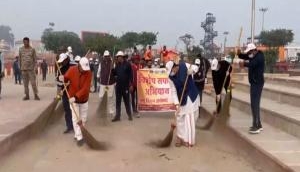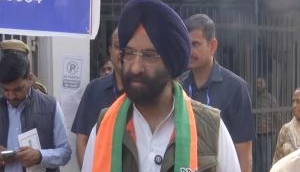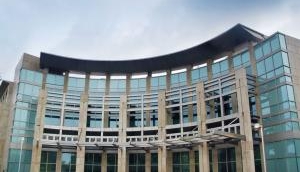
The stage is set for the Uttar Pradesh elections, which will be held in seven phases between February and March this year.
The politically crucial state of Uttar Pradesh is all set to witness a tough fight between the ruling Samajwadi Party, Bahujan Samaj Party (BSP) and the Bharatiya Janata Party (BJP) in the upcoming 17th state assembly elections.
The Congress, which has fielded Sheila Dikshit as its chief ministerial candidate, is, as of now, keeping a close eye on the ongoing friction between the two warring factions of the Samajwadi Party.
The grand old party, which has hired election strategist Prashant Kishor, will look forward to an alliance with a party or parties to ensure that it has some control over Lucknow.
On 4 January, the Election Commission of India announced the election schedule for Uttar Pradesh and four other states -- Goa, Manipur, Punjab and Uttarakhand.
Polls in Uttar Pradesh will be held from 11 February to 8 March in seven phases. The term of the present Samajwadi Party government of Chief Minister Akhilesh Yadav will end on 27 May. The elections will decide not only who will head the next administration in the state, but also give an inclination as to the expected vote swing in the 2019 general elections.
In the 2012 state assembly election, the Samajwadi Party secured a majority and formed the government under the leadership of Akhilesh Yadav.
In January last year, the Election Commission of India (ECI) published the updated electoral rolls for all 403 assembly seats.
In July last year, the Election Commission decided to increase the number of polling booths in Uttar Pradesh for the 2017 assembly elections.
The key issue in this year's polls is likely to be law and order. Caste and religion will be the two other factors likely to determine voter swing, though the Supreme Court has prohibited their use in soliciting of votes.
The BJP may try to highlight the success of the Indian Army in carrying out surgical strikes across the Line of Control (LoC) to invoke the nationalist spirit, while the Congress may focus on the plight of farmers and demand loan waivers post-demonetisation.
The Samajwadi Party and its main rival the Bahujan Samaj Party (BSP) are both hoping to woo their respective vote-banks, including among the minorities, scheduled castes and other castes.
Another major issue that could impact this year's election is demonetisation. Prime Minister Narendra Modi has repeatedly stated that demonetisation is not election related, but a long-term measure to counter corruption and the use of black money. He has also said that he is committed to changing the quality of life of the poor.
Addressing the BJP's national executive last month, Prime Minister Modi had saluted the "inner strength" of the poor and said they had voluntarily supported demonetisation despite facing several hardships. He said then that "serving people was equivalent to serving God".
Senior BJP leader and Union Minister Ravi Shankar Prasad had also said then, "The Prime Minister said some people worry about lifestyle, but our priority is to make the quality of life better for the poor and underprivileged. Poverty is an opportunity for us to serve those less fortunate."
While Prime Minister Modi will be aspiring for a second victorious run after winning the state by a landslide in the 2014 general elections, Congress vice-president Rahul Gandhi will be hoping to get his foot in the door in the country's most populous state and the fourth largest in terms of area.
It is being speculated that the 2017 elections in Uttar Pradesh will be a close contest between the BSP and BJP. Since August 2016, the BSP has held a series of 'Sarvajan Hitay, Sarvajan Sukhay' rallies starting from Agra, followed by mega rallies in Azamgarh, Allahabad and Saharanpur. In these rallies, BSP supremo Mayawati has repeatedly criticized the misrule of the Samajwadi Party, its communal politics and the BJP's unfulfilled promises of 'Achhe Din'.
The BSP has given over 100 tickets to Muslim candidates, the highest allotment to a particular community in the state till date.
In August 2016, four Muslim MLAs -- three from the Congress (Nawab Kazim Ali Khan, Dilnawaz Khan, Mohammad Muslim Khan) and one from the Samajwadi Party (Nawazish Alam Khan) and also a former BJP minister Awadesh Kumar Verma -- joined the BSP. It is being speculated that Muslims may prefer the BSP over the Samajwadi Party.
The BJP on the other hand will try to woo voters in Uttar Pradesh through the Ram Janmabhoomi plank.
The Samajwadi Party has released its first list of 142 contestants for the elections and is hoping to return for a second consecutive five-year term despite the party's first family being engaged in internal strife.
How and whether party supremo Mulayam Singh Yadav and his son Chief Minister Akhilesh Yadav arrive at a political settlement before the polls is anyone's guess.
Demonetisation is expected to have a significant impact on the polls, as it will bring down poll expenditures considerably. Parties riding till now on significant cash inflows to win over voters are in danger.
It will be interesting to view the prospects and performance of the BSP from the sidelines, as according to experts, it is emerging as a strong claimant for forming the next government under the leadership of Mayawati.
The BSP can sail through provided Mayawati is able to convince the Muslim votebank to vote for her party. The BSP's core vote of 21.5 percent Dalits is not intact. The coalition of Dalits, Muslims and Brahmins that had brought Mayawati to power in 2007 has also split up.
Though the party's Brahmin face S.C. Mishra is extensively touring the state, the party's fate remains in the hands of Muslims.
The BJP has been eyeing Uttar Pradesh ever since its spectacular victory in the 2014 general elections. Party president Amit Shah launched the 'Parivartan Yatra', a series of public mobilisation programmes in December and January with the clarion call for change and improved governance. The party's trump card is Prime Minister Modi, who continues to be a popular figure in this politically crucial state.
Union Home Minister Rajnath Singh has appealed to the people of the state to end the BJP's 14-year vanvaas (exile). The party's latest gamble is demonetisation, which has raised the hopes of the people. Should the BJP deliver on its poll promise of sharing retrieved black money with the masses, it can expect to sweep the polls. Not doing so, will be an expensive gamble.
The Congress is making desperate and sincere efforts to revive itself in the state that it has ruled for about 40 years and is placing all of its electoral cards and ammunition in the hands of poll strategist Prashant Kishore, who has acquired a reputation after delivering wins for Prime Minister Modi and the Mahgatbandhan of Janata Dal (United)/Rashtriya Janata Dal/Congress in Bihar under the leadership of Nitish Kumar.
Efforts are on to forge an alliance between the Congress, Samajwadi Party, RLD, RJD and JD (U).
The other issues that might polarise voters are the law and order incidents in Muzaffarnagar, Kairana and Dadri.
The assembly elections in Uttar Pradesh have been held on 16 occasions since 1951-52 and the state will go to polls for the 17th time next month to elect candidates campaigning and competing in 403 assembly constituencies.
The assembly elections were held as follows and the results were as follows:
1951/52 - Total: 430. Indian National Congress: 388/430, SP: 20, Jan Sangh: 2, Indian National Lok Dal: 15. Chief Ministers: Gobind Vallabh Pant, Sampurnanand.
1957 - Total: 430. Congress: 286, PSP: 44, BJS: 17, CPI: 9, Indian National Lok Dal: 74 (Chief Ministers: Sampurnanand, Chandra Bhanu Gupta)
1962 - (CMs: Chandra Bhanu Gupt, Sucheta Kripalani)
1967 - (CMs: Chandra Bhanu Gupt, Sucheta Kripalani) INC: 199/388 seats. Bharatiya Jana Sangh: 98, SSP: 44, CPI: 13, Swatantra Party: 12, PSP: 11
1969 - (CMs: C B Gupta, Charan Singh, Tribhuvana Narayana Singh, Kamalapati Tripathi, H N Bahuguna) Total: 425. Congress: 211, Bharatiya Kranti Dal: 98, BJS: 49, SSP: 33
1974 - (CMs: Bahuguna, Narayan Dutt Tiwari) Total: 425. Congress: 215, Bharatiya Kranti Dal: 106, BJS: 61, CPI: 16, NCO: 10
1977 - Janata Party: 352 out of 425 Congress: Approx 45-50. (This assembly saw Ram Naresh Yadav and Banarasi Das as CM)
1980 - (CMs: Vishwanath Pratap Singh, Shripati Mishra, N D Tiwari)
1985 - Total: 425. Congress: 269, Lok Dal (Charan Singh): 84, Janata: 20, BJP: 16
1989 - (This assembly saw Mulayam Singh Yadav as CM) Total: 425. JD: 208, INC: 94, BJP: 57
1991 - (This assembly saw Kalyan Singh as CM) Total: 425. BJP: 221, JD (Mulayam, et al.): 92, INC: 46, JP: 34, BSP: 12
1993 - (Chief Ministers: Mulayam Singh + Mayawati; SP+BSP coalition)
1996 - (CMs: Mayawati + Kalyan Singh + Rajnath Singh; BSP+BJP coalition for some period)
2002 - (Chief Minister(s): Mulayam Singh)
2007 - (Chief Minister(s): Mayawati)
2012 - (CM: Akhilesh Yadav.) Total: 403. SP: 224, BSP: 80, BJP: 47, Cong: 28
2017- Elections to be held and results to be declared.
In all, 14.05 crore people will be eligible to exercise their vote in this year's state assembly elections. Out of this total voter population, 7.7 crore are males and 6.3 crore are females. Out of the 403 seats up for grabs, any party or combine needs 202 seats to be declared the winner. In the 2012 polls, the Samajwadi Party won 224 seats, the Bahujan Samaj Party won 80 and the BJP 47.
-ANI







![BJP's Kapil Mishra recreates Shankar Mahadevan’s ‘Breathless’ song to highlight Delhi pollution [WATCH] BJP's Kapil Mishra recreates Shankar Mahadevan’s ‘Breathless’ song to highlight Delhi pollution [WATCH]](https://images.catchnews.com/upload/2022/11/03/kapil-mishra_240884_300x172.png)

![Anupam Kher shares pictures of his toned body on 67th birthday [MUST SEE] Anupam Kher shares pictures of his toned body on 67th birthday [MUST SEE]](https://images.catchnews.com/upload/2022/03/07/Anupam_kher_231145_300x172.jpg)






